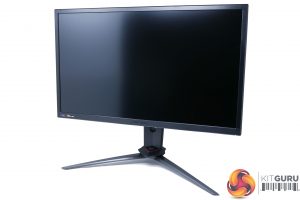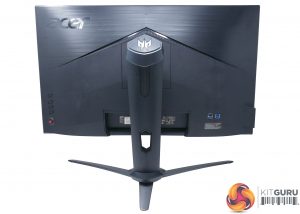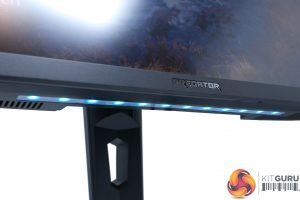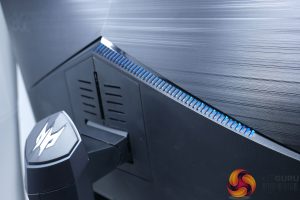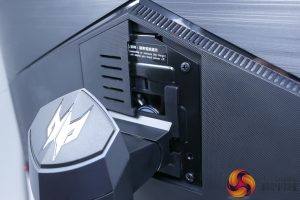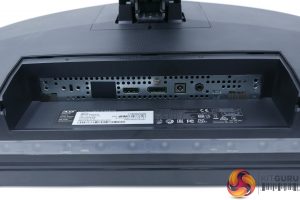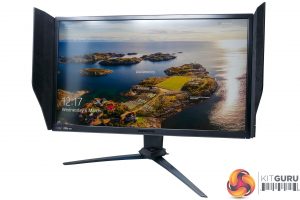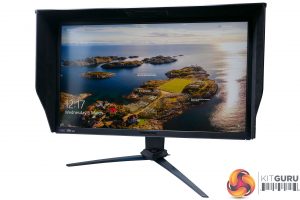The Acer XB273K arrives fully assembled and very well protected in its enormous box. There’s also none of the faff you get with some displays where you have to tip the box on its side to awkwardly slide the display out. Lift the top layer of foam out and you can pull the monitor straight out and onto your desk.
Once unwrapped you’ll find a display that’s smart and premium looking though is markedly chunkier than many 27inch displays we’ve seen recently. Around the edges is a thick bezel that stands proud of the display’s surface, rather than sitting flush. Meanwhile the backside has plenty of depth to it too.
This aside, the styling is excellent with Acer opting for a very muted look that’s all black and dark grey, with only the tiniest hint of red on the stand. It’s a far cry from the much more garish styling of some previous Acer displays, such as the XB271HU. We particularly like the slim-legged, all-metal base that’s both elegant and adds a premium touch to proceedings.
Adding a touch of pizazz are a couple of lighting zones. Shining down from under the display is a row of 12 RGB LEDs that you can use to cast a multi-coloured light onto the desk below. Meanwhile, round the back, there’s another row of lights hidden in the top ventilation grille.
We’ve seen several variations on having extra lights on monitors and most of them have left us nonplussed. However, the downlights here, in particular, are rather nice. They don’t feel garish and could even be considered practical as you can gently illuminate the area below your display – useful if your room is otherwise fairly dark.
Round the back of the display, the stand is fixed by a standard 100x100mm VESA mounting plate that’s covered over by a couple of removable plastic plates. These also cover perhaps the biggest turn off for this display: a fan.
This is used to cool the G-Sync HDR module and is on all the time, potentially creating a constant slight distraction, if your office/gaming space is particularly quiet. We measured the sound it produces at a distance of 30cm from the front of the screen and it registered at 32.5dB when the computer was idle and 33dB when gaming.
At 10cm from the front these figures increased to 33.6dB and 34.5dB respectively and if you stick you face right up against the back of the screen you’ll hear 44dB and 46dB of noise.
All told, it wasn’t loud enough to be heard over the noise from our test PC (when setup with the PC next to the desk) so didn’t really concern us, but you may find it more distracting.
Also round the back of the display you’ll find the connectivity, which is hidden behind a removable plastic plate. Prize this off and you’ll find sockets for one HDMI and one DisplayPort connection, along with the power input and a headphone jack socket. The display uses an external power brick that measures 143 x 63 x 30mm.
The headphone jack can be used to direct sound away from the monitor’s pair of 4W in-built speakers. There’s no microphone input for passing audio back to your computer from a headset, just the option to hear what’s being sent via the two video inputs.
As for the screen itself, it’s the same 120Hz, 4K IPS panel as used in the Acer X27 and that’s made by AU Optronics. Overclockable to 144Hz, it measures 27-inch from corner to corner, giving it a pixel density of 180ppi.
The display can deliver true 10-bit colour, as required for HDR content (as well as working in broader colour spaces like AdobeRGB) but it can only deliver this at up to 98Hz refresh rate and only when HDR mode is engaged. If you turn off HDR there’s no option to work in 10-bit colour as you’d get on professional-grade displays.
Behind the LCD panel is the key difference between this and the Acer X27, which is the lack of a multi-zone backlight. Acer touts the display as having a dynamic contrast to produce HDR-like contrast but this just works by changing the overall brightness of the backlight, not individual zones of it.
Finally, there’s the anti-glare hood to consider. Traditionally something you’d find on professional-grade monitors, we’re beginning to see these on gaming monitors, with the logic being the same for both types of screen: the less external light you have hitting the surface of the screen, the more even and accurate an image you get. It doesn’t exactly feel essential here but it’s potentially useful if you’re eyeing up a screen like this both for gaming and work, or if your screen just happens to be in a particularly brightly lit room.
The side panels screw on and are hinged so you can move them out the way, while the top piece just drops into place.
 KitGuru KitGuru.net – Tech News | Hardware News | Hardware Reviews | IOS | Mobile | Gaming | Graphics Cards
KitGuru KitGuru.net – Tech News | Hardware News | Hardware Reviews | IOS | Mobile | Gaming | Graphics Cards


